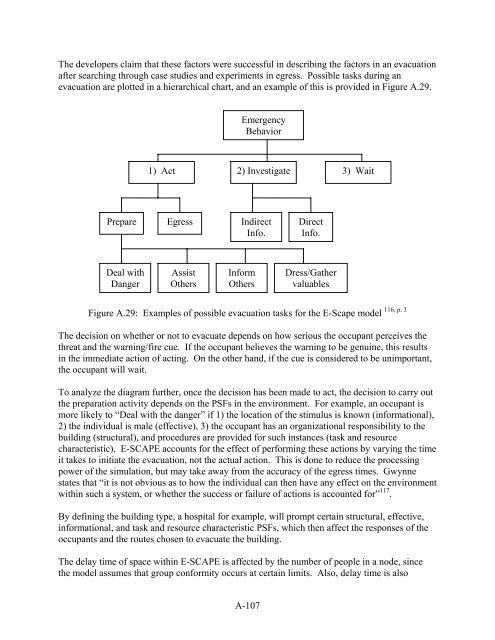A Review of Building Evacuation Models - NIST Virtual Library
A Review of Building Evacuation Models - NIST Virtual Library
A Review of Building Evacuation Models - NIST Virtual Library
You also want an ePaper? Increase the reach of your titles
YUMPU automatically turns print PDFs into web optimized ePapers that Google loves.
The developers claim that these factors were successful in describing the factors in an evacuation<br />
after searching through case studies and experiments in egress. Possible tasks during an<br />
evacuation are plotted in a hierarchical chart, and an example <strong>of</strong> this is provided in Figure A.29.<br />
Emergency<br />
Behavior<br />
1) Act 2) Investigate 3) Wait<br />
Prepare Egress Indirect<br />
Info.<br />
Direct<br />
Info.<br />
Deal with<br />
Danger<br />
Assist<br />
Others<br />
Inform<br />
Others<br />
Dress/Gather<br />
valuables<br />
Figure A.29: Examples <strong>of</strong> possible evacuation tasks for the E-Scape model<br />
116, p. 3<br />
The decision on whether or not to evacuate depends on how serious the occupant perceives the<br />
threat and the warning/fire cue. If the occupant believes the warning to be genuine, this results<br />
in the immediate action <strong>of</strong> acting. On the other hand, if the cue is considered to be unimportant,<br />
the occupant will wait.<br />
To analyze the diagram further, once the decision has been made to act, the decision to carry out<br />
the preparation activity depends on the PSFs in the environment. For example, an occupant is<br />
more likely to “Deal with the danger” if 1) the location <strong>of</strong> the stimulus is known (informational),<br />
2) the individual is male (effective), 3) the occupant has an organizational responsibility to the<br />
building (structural), and procedures are provided for such instances (task and resource<br />
characteristic). E-SCAPE accounts for the effect <strong>of</strong> performing these actions by varying the time<br />
it takes to initiate the evacuation, not the actual action. This is done to reduce the processing<br />
power <strong>of</strong> the simulation, but may take away from the accuracy <strong>of</strong> the egress times. Gwynne<br />
states that “it is not obvious as to how the individual can then have any effect on the environment<br />
within such a system, or whether the success or failure <strong>of</strong> actions is accounted for” 117 .<br />
By defining the building type, a hospital for example, will prompt certain structural, effective,<br />
informational, and task and resource characteristic PSFs, which then affect the responses <strong>of</strong> the<br />
occupants and the routes chosen to evacuate the building.<br />
The delay time <strong>of</strong> space within E-SCAPE is affected by the number <strong>of</strong> people in a node, since<br />
the model assumes that group conformity occurs at certain limits. Also, delay time is also<br />
A-107
















